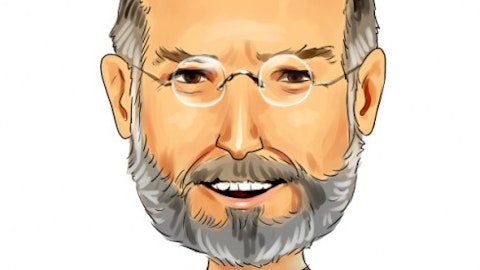On this day in economic and business history …
The world’s first mass-produced “portable” computer (a computer in the true sense, and not just a big calculator) was introduced to the tech public on this day in 1981. Engadget has the backstory:
On April 3rd, 1981, Adam Osborne unveiled the Osborne 1 at the West Coast Computer Faire in San Francisco. It had a 4 MHz Zilog Z80 CPU, two single-sided floppy drives, 64K of RAM, and a five-inch monochrome CRT display. Nothing particularly special there, even back in the day. No, what made the Osborne 1 extraordinary was the fact that the 24-pound plastic machine had a carrying handle on the back — and at the bargain price of $1,795 with software included, it became one of the first mass-produced portable computers to succeed. Which, of course, spurred competitors to create an army of even more luggable, loveable machines.

The rise of Osborne Computer on the back of the Osborne 1 was dizzying, as Technologizer recounts in a comprehensive piece on the company and its groundbreaking founder:
The fact that the Osborne 1 was a fully functioning personal computer in a portable case captured the imagination of techies in 1981. … The first Osborne 1 units shipped to dealers in June 1981. In August 1982, the company sold $10 million worth of computers; for the fiscal year that ended in February 1983, its revenues reached $100 million.
This incredible growth was followed by an equally stunning collapse, which has since given rise to the cautionary “Osborne Effect,” which warns tech companies against preannouncing ambitious projects that are still far from market-ready, as vendors and consumers will hold off on buying existing models in anticipation of a newer, better machine. However, it’s debatable whether Osborne’s too-soon PR campaign is solely to blame for the company’s failure. After all, by 1983, Osborne had to compete with the International Business Machines Corp. (NYSE:IBM) PC, which was released in 1981 and quickly became the closest thing computing had to an industry standard, thanks to a relatively easy reverse-engineering process.
The Osborne 1 was good enough, but it wasn’t great, and so it was extremely vulnerable to products that seemed even a little better and a little cheaper — products like the Compaq Portable, the first IBM-compatible portable PC. Compaq’s early portable success brought it to even greater heights than Osborne would ever reach, leading to a $25 billion combination with Hewlett-Packard Company (NYSE:HPQ) in 2001. Hewlett-Packard Company (NYSE:HPQ) is still one of the world’s leading laptop vendors, but in recent years, nearly all laptop manufacturing has shifted to a handful of Chinese companies.
The world offered the portable form factor a resounding vote of confidence three decades after Osborne practically invented the category. More than 230 million laptops were bought around the world in 2010 — but just as the Osborne was made obsolete by smaller, better, cheaper portables, the laptop is also finding itself under siege from a newer form factor, which won the market exactly 29 years after Adam Osborne gave the world its first luggable: the tablet.

How do you top an iPhone?
Apple Inc. (NASDAQ:AAPL)‘s iPad went on sale bright and early on April 3, 2010. The “magical and revolutionary” tablet, in the words of Apple Inc. (NASDAQ:AAPL) CEO Steve Jobs, had been the subject of intense media scrutiny leading up to its public release. Some had questioned the value of the new form factor. Some mocked the name, which brought to mind feminine-hygiene products. Others breathlessly awaited the iPad’s debut, expecting a device that would be every bit the hit of the iPhone, released three years earlier under an exclusive contract with AT&T’s mobile network.
The latter camp proved correct. On April 3, lines snaked out the doors of Apple Inc. (NASDAQ:AAPL) Stores around the country, even though many buyers weren’t quite sure what they would actually do with the new device. One line-camper in San Francisco, waiting to pick up an iPad for her husband, told a New York Times reporter: “I have no idea what he’ll do with it. … I’m sure he’ll use it a lot, whatever it is. He told me I’m not allowed to open it.”

In its first year, the iPad owned the tablet category, with an 83% share of the 18 million tablets sold in 2010. The dominance continued through 2011, as Apple Inc. (NASDAQ:AAPL) sold nearly as many tablets during the 2011 holiday season (15.4 million ) as were sold throughout 2010, good for a 58% share of the tablet market. By the fall of 2012, Apple Inc. (NASDAQ:AAPL) had sold over 100 million iPads . Over 100 million tablets were estimated to have sold in 2012, and Gartner projects that roughly 370 million tablets will be sold worldwide in 2016 . That would add a far greater sales volume to what is already a far faster adoption rate than laptops (or portable PCs, at least) have ever managed to achieve in over three decades.
The article From Osborne to iPad: 3 Decades of Portable Computing originally appeared on Fool.com and is written by Alex Planes.
Fool contributor Alex Planes holds no financial position in any company mentioned here. Add him on Google+ or follow him on Twitter @TMFBiggles for more insight into markets, history, and technology.The Motley Fool recommends Apple. The Motley Fool owns shares of Apple and International Business Machines (NYSE:IBM).
Copyright © 1995 – 2013 The Motley Fool, LLC. All rights reserved. The Motley Fool has a disclosure policy.

